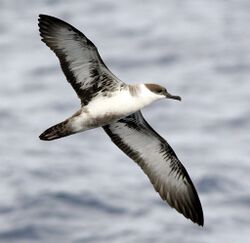Biology:Shearwater
| Shearwaters | |
|---|---|

| |
| Great shearwater | |
| Scientific classification | |
| Kingdom: | Animalia
|
| Phylum: | |
| Class: | |
| Order: | |
| Family: | |
| Genera | |
|
Calonectris | |
| Diversity | |
| 7 genera and 38 species | |
Shearwaters are medium-sized long-winged seabirds. There are more than 30 species of shearwaters, a few larger ones in the genus Calonectris and many smaller species in the genus Puffinus. The Procellaria petrels and Bulweria were believed to belong to this group, but are only distantly related based on more recent studies, while the Pseudobulweria and Lugensa "petrels" are more closely related.[1][2] The genus Puffinus can be divided into a group of small species close to Calonectris and a few larger ones more distantly related to both.[3]
These birds are most common in temperate and cold waters. They are pelagic outside the breeding season.
These tubenose birds fly with stiff wings and use a "shearing" flight technique (flying very close to the water and seemingly cutting or "shearing" the tips of waves) to move across wave fronts with the minimum of active flight. This technique gives the group its English name.[4] Some small species, like the Manx shearwater are cruciform in flight, with their long wings held directly out from their bodies.
Many are long-distance migrants, perhaps most spectacularly sooty shearwaters, which cover distances in excess of 14,000 km (8,700 mi) from their breeding colony on the Falkland Islands (52°S 60°W) to as far as 70° north latitude in the North Atlantic Ocean off northern Norway. One study found Sooty shearwaters migrating nearly 40,000 miles (64,000 kilometers) a year, which would give them the longest animal migration ever recorded electronically.[5] Short-tailed shearwaters perform an even longer "figure of eight" loop migration in the Pacific Ocean from Tasmania to as far north as the Arctic Ocean off northwest Alaska.
They are long-lived. A Manx shearwater breeding on Copeland Island, Northern Ireland, is currently (2003/2004) the oldest known wild bird in the world: ringed as an adult (at least 5 years old) in July 1953, it was retrapped in July 2003, at least 55 years old. Manx shearwaters migrate over 10,000 km (6,200 mi) to South America in winter, using waters off southern Brazil and Argentina, so this bird has covered a minimum of 1,000,000 km (620,000 mi) on migration alone.
Shearwaters come to islands and coastal cliffs only to breed. They are nocturnal at the colonial breeding sites, preferring moonless nights to minimize predation. They nest in burrows and often give eerie contact calls on their night-time visits. They lay a single white egg.
They feed on fish, squid, and similar oceanic food. Some will follow fishing boats to take scraps, commonly the sooty shearwater; these species also commonly follow whales to feed on fish disturbed by them. Their primary feeding technique is diving, with some species diving to depths of 70 m (230 ft).
Shearwaters are part of the family Procellariidae, which also includes fulmarine petrels, prions, and gadfly petrels.
List of species

- Calonectris
- Calonectris diomedea, Cory's shearwater
- Calonectris edwardsii, Cape Verde shearwater
- Calonectris leucomelas , streaked shearwater
- Puffinus
- Puffinus nativatis, Christmas shearwater
- Puffinus subalaris, Galápagos shearwater
- Puffinus bryani, Bryan's shearwater
- Puffinus puffinus, Manx shearwater
- Puffinus yelkouan, yelkouan shearwater
- Puffinus mauretanicus, Balearic shearwater
- Puffinus huttoni, Hutton's shearwater
- Puffinus opisthomelas, black-vented shearwater
- Puffinus auriculatus, Townsend's shearwater
- Puffinus newelli, Newell's shearwater or Hawaiian shearwater
- Puffinus gavia, fluttering shearwater
- Puffinus assimilis, little shearwater
- Puffinus elegans, subantarctic shearwater
- Puffinus lherminieri, Audubon's shearwater
- Puffinus (lherminieri) bailloni, tropical shearwater or Baillon's shearwater, not agreed upon as to whether a subspecies or species
- Puffinus (lherminieri) baroli, Barolo shearwater or Macronesian shearwater, not agreed upon as to whether a subspecies or species
- Puffinus (lherminieri) boydi, Boyd's shearwater, not agreed upon as to whether a subspecies or species
- Puffinus (lherminieri) bannermani, Bannerman's shearwater, not agreed upon as to whether a subspecies or species
- Puffinus (lherminieri) persicus, Persian shearwater, not agreed upon as to whether a subspecies or species
- Puffinus heinrothi, Heinroth's shearwater
- †Puffinus olsoni, lava shearwater or Olson's shearwater
- Ardenna
- Ardenna pacifica, wedge-tailed shearwater
- Ardenna bulleri, Buller's shearwater
- Ardenna grisea, sooty shearwater
- Ardenna tenuirostris, short-tailed shearwater or mutton bird
- Ardenna creatopus, pink-footed shearwater
- Ardenna carneipes, flesh-footed shearwater
- Ardenna gravis, great shearwater
- Pseudobulweria
- Pseudobulweria macgillivrayi, Fiji petrel
- Pseudobulweria rostrata, Tahiti petrel
- Pseudobulweria becki, Beck's petrel
- Pseudobulweria aterrima, Mascarene petrel
- Lugensa
- Lugensa brevirostris, Kerguelen petrel
- Bulweria
- Bulweria bulwerii, Bulwer's petrel
- Bulweria fallax, Jouanin's petrel
- †Bulweria bifax, small St. Helena petrel
- Procellaria
- Procellaria cinerea, grey petrel
- Procellaria aequinoctialis, white-chinned petrel
- Procellaria conspicillata, spectacled petrel
- Procellaria parkinsoni, black petrel
- Procellaria westlandica, Westland petrel
References
- ↑ Bretagnolle, Vincent; Attié, Carole; Pasquet, Eric (1998). "Cytochrome-B evidence for validity and phylogenetic relationships of Pseudobulweria and Bulweria (Procellariidae)" (PDF). The Auk 115 (1): 188–195. doi:10.2307/4089123. http://sora.unm.edu/sites/default/files/journals/auk/v115n01/p0188-p0195.pdf.
- ↑ Nunn, Gary B.; Stanley, Scott E. (1998). "Body Size Effects and Rates of Cytochrome b Evolution in Tube-Nosed Seabirds" (PDF). Molecular Biology and Evolution 15 (10): 1360–1371. doi:10.1093/oxfordjournals.molbev.a025864. PMID 9787440. http://mbe.oxfordjournals.org/content/15/10/1360.full.pdf. Corrigendum
- ↑ Austin, Jeremy J. (1996). "Molecular Phylogenetics of Puffinus Shearwaters: Preliminary Evidence from Mitochondrial Cytochrome b Gene Sequences". Molecular Phylogenetics and Evolution 6 (1): 77–88. doi:10.1006/mpev.1996.0060. PMID 8812308.
- ↑ Shearwaters (3rd ed.), Oxford University Press, September 2005, http://oed.com/search?searchType=dictionary&q=Shearwaters (Subscription or UK public library membership required.)
- ↑ Longest Animal Migration Measured, Bird Flies 40,000 Miles a Year
External links
- Shearwater videos on the Internet Bird Collection

